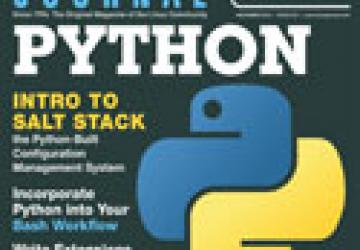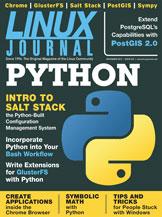November 2012 Issue of Linux Journal: Python


Indiana was the Dog's Name
My wife is afraid of snakes. Actually, "afraid" may not be a big enough word. My wife is terrifyingly and abundantly mortified of snakes. Like any good husband, I remind her that Indiana Jones also was afraid of snakes, so she's in good company. This month, our issue is all about vipers—no, wait, Python. Whether you're a new programmer or an old coder, Python is flexible, cross-platform and really quite robust.
Joey Bernard gets the Python train rolling in our UpFront section. Sympy is a library for Python providing a full-featured computer algebra system. Although I have no problem with my kids learning long division, there certainly are some great advantages to using computers for complex maths.
Reuven M. Lerner takes a trip into HTML5 land. He shows how to create Chrome extensions, which can be entire applications running inside your browser. With HTML5, CSS, JavaScript and so on, Chrome applications can be robust, complex and a far cry from the Web applications of just a few years ago. In fact, if you recall from last month, I use a Chrome extension for writing my Linux Journal articles.
Our other resident programmer is Dave Taylor, who teaches how to use SIGALARM in scripts to add valuable complexity to scripts that need it. That might sound overwhelming, but Dave explains what he's doing along the way, and in the end, what seems like a complex and confusing idea makes sense. Speaking of confusing ideas, I had to do a double take when I read Kyle Rankin's article on his new Android device. Yes, you read that right, Kyle uses Android. Like most things Kyle does, however, it's more than just switching from his N900 to a new phone. He's never happy with just a phone; Kyle wants a communication device that doubles as an International Space Station. This month, he comes close.
I haven't been happy with the lack of hate mail in my inbox recently, so I thought it would be a good time to write an article about Windows. Okay, to be honest, it's a little more complicated than that, but I fully expect to get hate mail nonetheless! As a Linux user currently stuck in a job with a Windows infrastructure (not here at Linux Journal, of course), I'm working hard to feel as at home as possible. I share my struggles with you, and maybe make Windows a little easier to deal with.
After my sacrilegious foray into the Windows world, Richard Delaney brings us back to topic with his article on replacing Bash scripts with Python. Since Bash scripting is the only form of programming I ever do, I'm both hesitant and excited about this topic. Learning a new language would be very beneficial for me, and if I can use it for the same purposes I use Bash, all the better!
GlusterFS is a fascinating distributed filesystem, which can scale to enormous size. If you're a Python programmer and want to add functionality to GlusterFS, Jeff Darcy's article is perfect. Integrating code across languages can be a daunting task, but with the flexibility of Python, Jeff shows us it's worth the effort.
Configuration management systems are all the rage. This is obviously because it makes managing large numbers of servers much easier to do. A part of me thinks it might be due to the funny sounding project names as well. Puppet and Chef are both fairly well known, and thanks to their names, they're easy to remember. This month, Ben Hosmer introduces us to a Python-based configuration management tool named Salt Stack. Apparently having interesting names is a requirement in the configuration management world, and Salt Stack lives up to that. Does it live up to the functionality of its competition? Ben lets us know.
Stefano Iacovella finishes off this issue with PostGIS. PostgreSQL is a great open-source database system, but for keeping track of spatial data (think maps), it really needs to run with an extension like PostGIS in order to handle that type of stuff. Not only does PostGIS allow for complex mapping of spatial data, but it also can handle four-dimensional information as well. Good luck to Indiana Jones if he tries to follow a four-dimensional treasure map though. It's hard enough to keep track of snakes in three dimensions!
This month is a well-rounded issue, which is heavy on the Python. If you're not a programmer, or don't want to learn about programming, fear not. We still have a lineup of content sure to please. Oh, and before you think of sending a rubber snake to the Linux Journal office, keep in mind that I'm not afraid of them at all. Now bees? That's another story altogether.
Available to Subscribers: November 1










